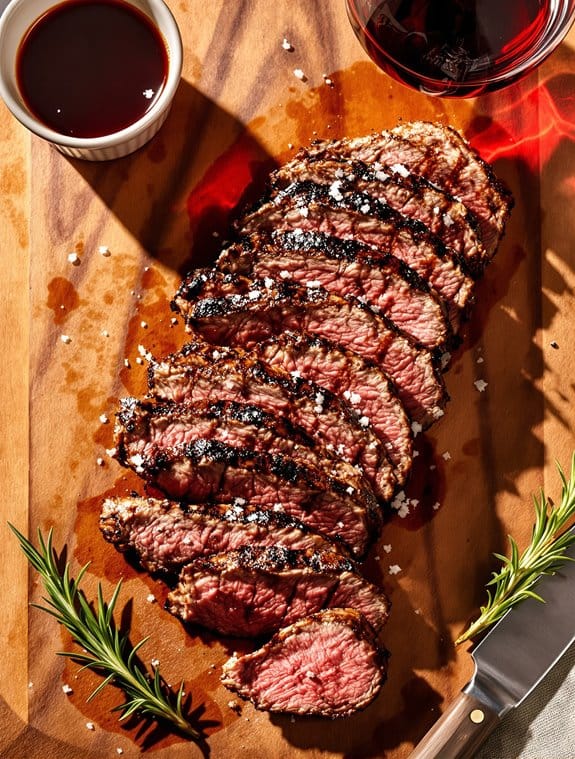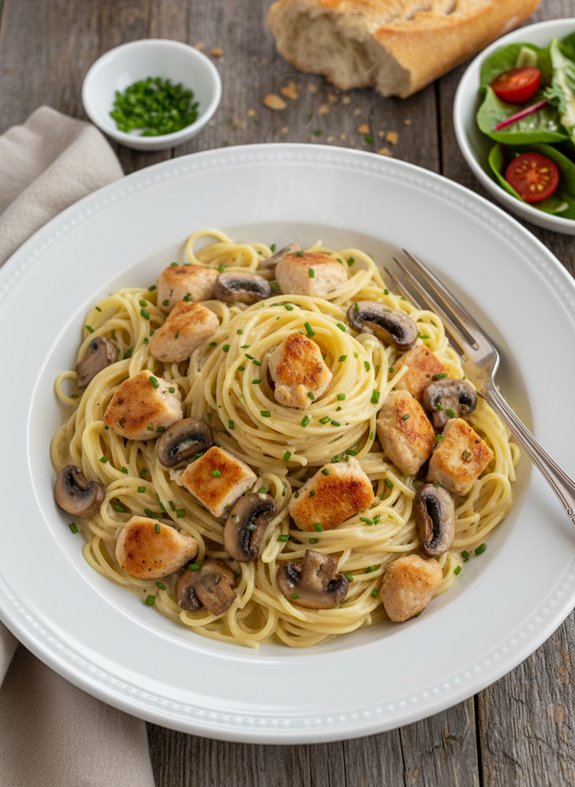Why You’ll Love this Cabernet-Marinated Flat Iron Steak
There are three incredible reasons why this Cabernet-Marinated Flat Iron Steak will become your new favorite dinner option.
First, the combination of cabernet, garlic, and herbs creates a flavor profile that’s both sophisticated and comforting.
Second, flat iron steak is remarkably tender when cooked properly to medium-rare, giving you steakhouse quality at home.
Finally, the entire prep takes just minutes, with the wine doing all the heavy lifting during that one-hour marinade.
Who doesn’t love a dish that’s impressive enough for guests but simple enough for weeknights? Trust me, it’s a game-changer.
What Ingredients are in Cabernet-Marinated Flat Iron Steak?
The beauty of this Cabernet-Marinated Flat Iron Steak lies in its simplicity and depth of flavor. You’ll find that the ingredient list strikes that perfect balance—not so complicated that you need to hunt down obscure items, but thoughtfully composed to create layers of savory goodness.
The cabernet sauvignon forms the backbone of the marinade, infusing the meat with rich, complex notes while also helping to tenderize it.
- 1-2 pounds flat iron steaks (or flank steak as an alternative)
- 2 tablespoons olive oil
- 2 garlic cloves, mashed
- 1 teaspoon Italian parsley, chopped
- 1 teaspoon rosemary, chopped
- 1/4 cup cabernet sauvignon wine
- Salt, to taste
- Generous amount of freshly ground black pepper
- 1/2 teaspoon dry mustard
When shopping for this recipe, quality matters. Try to find a nicely marbled flat iron steak from your butcher if possible—this cut delivers exceptional tenderness and flavor for the price.
For the wine, you don’t need to splurge on anything expensive; a decent, drinkable cabernet works perfectly for marinating.
And a little tip? Fresh herbs make a noticeable difference here, but in a pinch, dried herbs will work too—just reduce the amounts by half since dried herbs are more concentrated in flavor.
How to Make this Cabernet-Marinated Flat Iron Steak

Making this Cabernet-Marinated Flat Iron Steak couldn’t be more straightforward, and the results are absolutely worth the minimal effort.
Start by combining 2 tablespoons of olive oil, 2 mashed garlic cloves, 1 teaspoon of chopped Italian parsley, and 1 teaspoon of chopped rosemary in a bowl. Pour in 1/4 cup of cabernet sauvignon wine, which gives this marinade its signature flavor profile. Season with salt (don’t be shy here), a generous amount of freshly ground black pepper (the “generous” part is important—the pepper creates a beautiful crust when grilled), and 1/2 teaspoon of dry mustard. Whisk everything together until well combined, creating a fragrant, wine-infused bath for your steak.
Place your 2 pounds of flat iron steaks (or a single 2-pound flank steak if you’re substituting) in a shallow dish or zip-top bag and pour the marinade over them. Make sure every inch of the meat is coated—I like to massage the marinade into the steaks a bit to help it penetrate.
Now comes the waiting game—let the steaks marinate for at least one hour. This isn’t one of those overnight marinades; the wine can actually start breaking down the meat too much if left too long. During this hour, the acid in the wine works its magic, tenderizing the meat while the herbs and spices infuse it with flavor.
When you’re ready to cook, fire up your grill to high heat. You want those grates screaming hot to get a proper sear. Remove the steaks from the marinade, letting excess liquid drip off, and place them directly over the hot coals. Cook for just 4 minutes per side for medium-rare—any more and you risk losing the tenderness that makes flat iron steak so special.
The wine in the marinade will help create a gorgeous caramelized crust while sealing in the juices. Remember that flat iron is best enjoyed rare to medium-rare, so resist the urge to cook it longer. After grilling, let the steaks rest for about 5 minutes before slicing against the grain to maximize tenderness. Those glorious juices need time to redistribute throughout the meat, making every bite succulent and flavorful.
Cabernet-Marinated Flat Iron Steak Substitutions and Variations
While this classic recipe shines with flat iron steak, you’ll find it’s remarkably adaptable when your preferred cut isn’t available at the butcher counter.
I’ve successfully used flank steak (as the recipe suggests), but ribeye, sirloin, and even skirt steak work beautifully with this marinade.
Not a cabernet fan? Try merlot or pinot noir instead.
The aromatics are flexible too—swap rosemary for thyme or add oregano for a Mediterranean twist. Sometimes I’ll throw in a splash of balsamic vinegar for extra tang.
The marinade time can stretch to overnight if you’re working with tougher cuts.
Makes meal prep so much easier.
What to Serve with Cabernet-Marinated Flat Iron Steak
When pairing sides with this cabernet-marinated flat iron steak, I always consider complementary flavors that enhance rather than compete with the wine-infused beef.
My go-to combination includes roasted garlic mashed potatoes, which soak up those delicious meat juices, and a simple arugula salad with lemon vinaigrette to cut through the richness.
Grilled asparagus works beautifully too, especially when finished with a sprinkle of sea salt.
For something heartier, try mushroom risotto—those earthy notes mirror the cabernet perfectly.
And honestly, can you ever go wrong with crusty bread for mopping up that incredible marinade? I certainly can’t resist.
Final Thoughts
After experimenting with this cabernet-marinated flat iron steak recipe countless times, I’ve come to appreciate how such a simple preparation can transform an affordable cut into something truly special.
The magic happens in that hour of marinating, where the wine, garlic, and herbs work their alchemy on the meat.
What I love most? The versatility. Serve it for a casual weeknight dinner or slice it thin for an impressive dinner party centerpiece.
And those leftovers? Pure gold for sandwiches or salads the next day. Trust me, this recipe will become your reliable go-to when you want maximum flavor with minimal fuss.

Cabernet-Marinated Flat Iron Steak
Ingredients
Equipment
Method
- In a mixing bowl, combine olive oil, mashed garlic cloves, chopped Italian parsley, and chopped rosemary.
- Pour in the cabernet sauvignon wine, then add salt, a generous amount of freshly ground black pepper, and dry mustard. Whisk until well combined.
- Place flat iron steaks in a shallow dish or zip-top bag and pour the marinade over them, ensuring all surfaces are coated. Massage the marinade into the meat slightly.
- Allow steaks to marinate for 1 hour at room temperature. This is sufficient time for the wine to tenderize the meat without breaking it down too much.
- Preheat your grill to high heat until the grates are very hot.
- Remove steaks from marinade, letting excess liquid drip off, and place directly over high heat.
- Grill for approximately 4 minutes per side for medium-rare doneness, which is ideal for flat iron steak.
- Remove from grill and let rest for 5 minutes before slicing against the grain to maximize tenderness.



